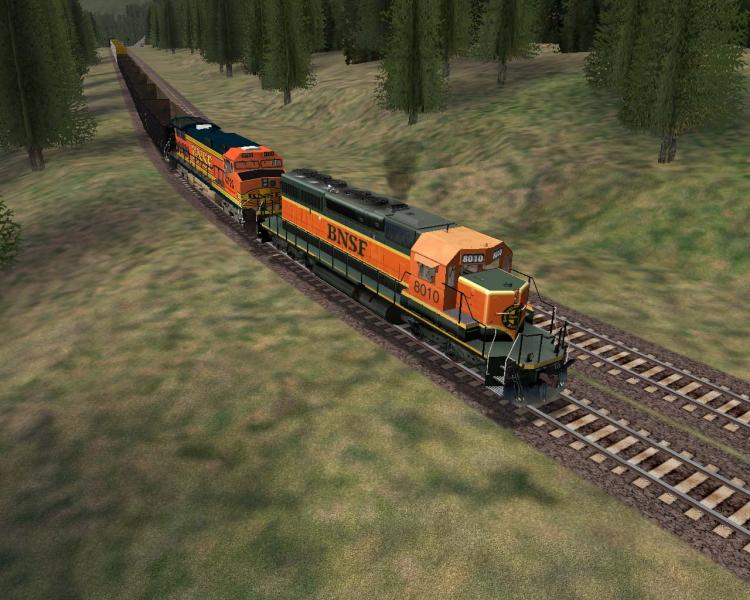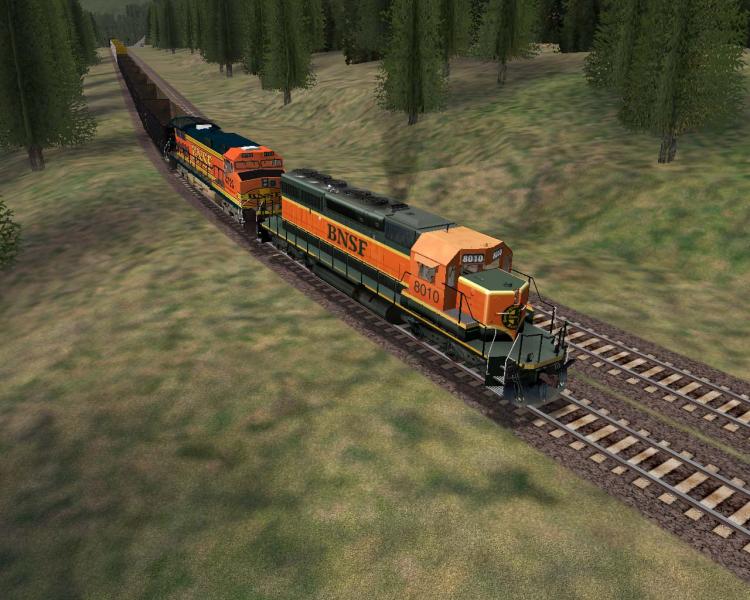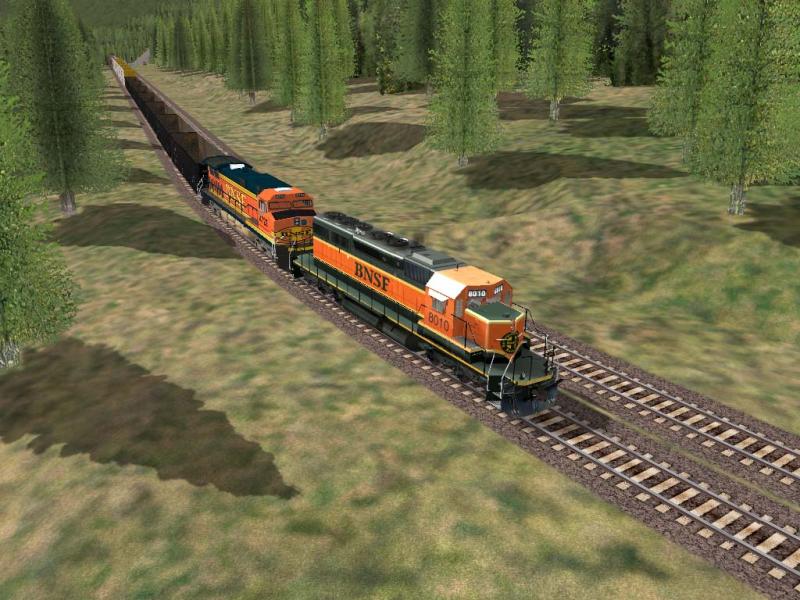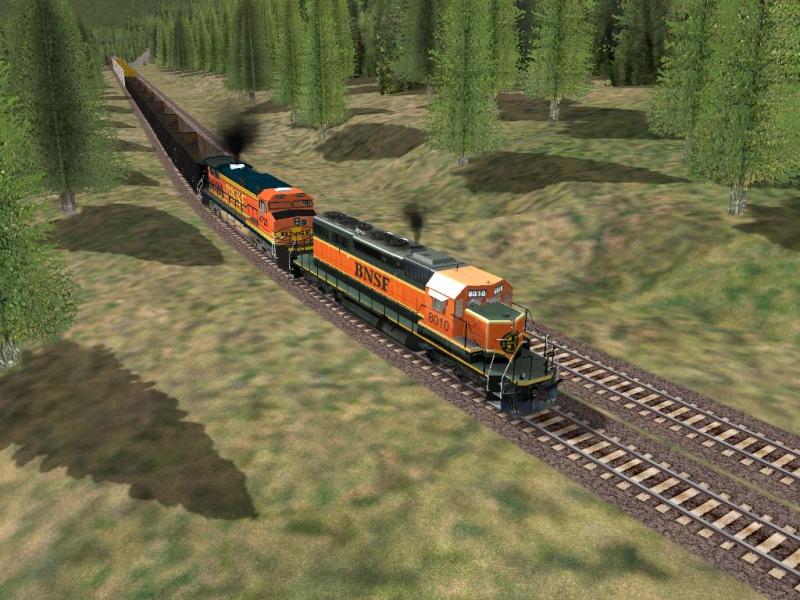How is the Smoke?
#81

Posted 25 January 2014 - 09:42 PM
http://i40.tinypic.com/24zkm4n.png
Although as you can see, there's a little problem that it would be nice to see solved... :) It seams like the smoke origin point seems to advance (usually advancing, at least is what I saw so far both in steam and diesel locomotives) as the train gains speed. Here's three more captures of the steam loco stopped and then starting to run...
http://i40.tinypic.com/334841y.png
http://i43.tinypic.com/2iuwzeu.png
http://i44.tinypic.com/2kk907.png
#82

Posted 26 January 2014 - 12:43 AM
MSTS idle:

MSTS full throttle:

OR idle:

OR full throttle:
Robert
#83

Posted 26 January 2014 - 12:50 AM
 PA1930, on 25 January 2014 - 09:42 PM, said:
PA1930, on 25 January 2014 - 09:42 PM, said:
Interesting. I checked that, and it actually seems to be moving with the throttle setting at higher speeds. Might be some sort of lag with the locomotive not keeping up with its smoke since those two locations are calculated in two totally different ways...
Robert
#84

Posted 26 January 2014 - 03:07 AM
 PA1930, on 25 January 2014 - 09:42 PM, said:
PA1930, on 25 January 2014 - 09:42 PM, said:
It's a weird problem because, as you clearly showed, we have the correct location for the smoke (i.e. when stationary). Personally, running at 60FPS, I don't notice nearly this much forward movement - unless I speed up the game to run at 500% or so. My theory is that the particle effects are running a small number of frames ahead of where they're meant to be. I'm going to fix it eventually. :)
#85

Posted 26 January 2014 - 03:47 AM
#86

Posted 26 January 2014 - 06:06 AM
 PA1930, on 25 January 2014 - 09:42 PM, said:
PA1930, on 25 January 2014 - 09:42 PM, said:
Although as you can see, there's a little problem that it would be nice to see solved... :whistling: It seams like the smoke origin point seems to advance (usually advancing, at least is what I saw so far both in steam and diesel locomotives) as the train gains speed. Here's three more captures of the steam loco stopped and then starting to run...
http://i40.tinypic.com/334841y.png
I seems to me that the stationary shot has the smoke slightly forward of the stack and with an axis tipped forwards. I think that this movement is caused by not having the correct point of origin first, and then a too large diameter for the exhaust.
#87

Posted 26 January 2014 - 06:46 AM
#88

Posted 26 January 2014 - 09:32 AM
I am wondering why the default deceleration color is now a bright orange (this appeared at rev #1960)?
public Color ExhaustDecelColor = Color.Orange;
http://imagizer.imageshack.us/v2/800x600q90/843/8ib7.jpg
If I were the driver I would be very concerned! :)
#89

Posted 26 January 2014 - 10:16 AM
 copperpen, on 26 January 2014 - 06:06 AM, said:
copperpen, on 26 January 2014 - 06:06 AM, said:
It made that effect because of that "randomness" of the particles direction. :blink: Otherwise it looked on its right place.
 James Ross, on 26 January 2014 - 06:46 AM, said:
James Ross, on 26 January 2014 - 06:46 AM, said:
Thank you very much James! Now it looks perfect! :)
http://i39.tinypic.com/11ka2ok.png
#90

Posted 26 January 2014 - 11:08 AM
Under ideal conditions, a diesel engine should not smoke at all, however, we all know that is not the way things work in the real world. So, we do see diesel smoke, but the reasons for it and its behavior differ widely. Here are some of the different smoke conditions.
1. White or blue smoke. This occurs primarily when the engine is trying to operate at far below its normal operating temperature (e.g., a cold startup). The whitish or blue smoke is a mixture of partially combusted and raw diesel fuel. It usually only lasts until the engine reaches operating temperature. This type of smoke can also occur when an engine has been idling for a protracted period and the engine operating temperature has dropped. "Wet stacking" occurs, which is an accumulation of soot and unburned fuel in the exhaust system. Typically, this will be expelled when the engine is throttled up, and usually does not last long. Blue or white smoke occurring in an engine at full operating temperature is usually a sign of a blown head gasket and results from the engine ingesting coolant into the combustion chambers. Engines exhibiting this don't usually run long in that condition. None of these smoke effects are ones that need to emulated in the sim. They are not that common, nor long-lasting.
2. Constant engine smoking throughout the RPM range. This is most commonly caused by dirty or malfunctioning fuel injectors, low engine compression (bad rings), or poor quality fuel. It is most commonly seen on older and very worn engines. A blown supercharger or turbocharger can also cause this condition. It is relatively common and worth emulation in the sim.
Before I continue with a discussion of other types of smoke, I want to discuss the various types of diesel engines in use. I will use US diesels as examples, but the various designs are pretty universal--also, a lot of non-US diesel locomotives use diesel engines (which I will henceforth refer to as the "prime mover"--the term usually used by railroad mechanical departments) either from the US or licensed by the US manufacturers. Prime movers can either be 2-cycle or 4-cycle, and they can be naturally aspirated, supercharged, turbocharged, or a combination of supercharging and turbocharging. All types have differing smoke behaviors. Two cycle prime movers only have two "strokes" per engine cycle, an intake stroke and a combination power/exhaust stroke. Four cycle prime movers have 4 strokes--an intake stroke, compression stroke, power stroke, and exhaust stroke. In the US, GM/EMD were/are the users of two-cycle prime movers--the 567, 645, and 710 variants being the different designs. All GE and Alco prime movers are 4-cycle. Two-cycle prime movers tend to be somewhat "dirtier" throughout their RPM range than are 4-cycles. This is because a small amount of exhaust gases remain in the combustion chamber after the exhaust stroke due to the design. Their advantage is that they can "spin up" in RPM faster than a 4-cycle prime mover and can often develop more horsepower per cubic inch of displacement than can a 4-cycle. 4-cycle prime movers operate more "cleanly" at any given constant RPM than most 2-cycles, but will often suffer from "throttle-lag" or "turbo-lag" when spinning up in RPM. This can cause them to smoke, often profusely (think Alco's here), on throttle up, the stack clearing after the engine RPM plateaus.
So here is the typical smoke behavior from some various prime movers:
EMD/GM Prime Movers (all 2-cycle)
EMD 567, naturally aspirated. Running properly, the 567 would generally smoke very little at idle. Being naturally aspirated, they would smoke moderately at throttle-up, that lasting a relatively short time because the RPM's spin up pretty rapidly. As engine RPM's increase, so would the smoke amount. An overworked naturally-aspirated 567, especially at higher altitudes, could smoke profusely at full throttle. (All first-generation EMD's that I know of were equipped with some variant of the naturally-aspirated 567.)
EMD 567, supercharged/turbocharged. All of the EMD prime movers (with the exception its short-lived foray into the 6,000 HP 4-cycle prime mover installed in few SD-90MAC's) after the SD18 have "enhanced" air induction using a combination of supercharging at low RPM and turbocharging at higher RPM. This design was implemented to reduce turbo lag at low RPM. The low RPM supercharging also helps expel exhaust gases from the prime mover at those low RPM's. Smoke behavior from these prime movers is pretty similar to the naturally-aspirated 567, except that level-RPM smoke was substantially reduced. Typically, these locomotives would have increasing smoke level as RPM's increased, but the smoke tended to not be fully opaque, more of a semi-transparent character. The GP20, GP30, and GP35 EMD locomotives got this prime mover.
EMD 645 non-turbocharged. Smoke behavior is about the same as the naturally aspirated 567--a little bit cleaner overall due to better combustion and fuel injection technology. Found primarily in switch engines, and the GP-38 and SD-38 locomotive.
EMD 645 supercharged/turbocharged. Similar to the 567 supercharged/turbocharged prime mover, but cleaner overall. Found in the ubiquitous "40 and 45" series locomotives (GP40, SD40, F40, F-45, SD-45 etc.).
EMD 710. All the 710's are supercharged/turbocharged. Their smoke behavior is much like the predecessor supercharged/turbocharged 645, but even cleaner yet. The early 710's would smoke some, but the newest models smoke very little.
General Electric FDL.
Unlike EMD, GE has been using the same basic engine block (with the exception of the relatively short-lived 6,000 hp prime mover used in the AC6000's, a design sourced from German manufacturer Deutz)--the FDL. All of the GE prime movers are 4-cycle and are equipped with a turbocharger (no supercharger). I've separated them more by era, than by model variation.
"Original" FDL. Until the appearance of the GEVO locomotives, the FDL16 was the prime mover found in the vast majority of GE models built. Like most of the prime movers, it got somewhat cleaner with each new generation--but its basic smoke characteristics have not changed. The FDL would typically smoke just a bit at idle. The big difference between the FDL 4-cycle and the EMD 2-cycle occurs at throttle up. The FDL suffers substantially from "turbo lag," meaning that until the exhaust gases increase enough to "spin up" the turbocharger, the prime mover is receiving more fuel from the injectors than it can completely combust. The visual effect is one of smoke--often near pure black smoke--occurring at throttle-up, then diminishing or even disappearing when the prime mover reaches an RPM plateau. This smoke can last for a fair amount of time because--being a 4-cycle prime mover--the RPM's increase much more slowly than does the RPM's in a 2-cycle prime mover. Each time the engineer notches out the throttle, this turbo-lag smoke behavior will occur, though the turbo lag smoking intensity tends to diminish as RPM levels get higher (the turbo is already spinning at higher throttle notches). Level RPM smoke levels can increase with RPM's, but often aren't as pronounced with the FDL compared to, say, an EMD 645 because the GE 4-cycle prime mover has more efficient combustion at level RPM compared to a 2-cycle.
GEVO (Evolution). The GEVO is a refined V12 version of the FDL16 V16. It is a very clean running prime mover. Running properly, one will almost never see much smoke out of one. They can exhibit a little "turbo lag" smoke, but it is very light.
Alco.
Alco prime movers were well known for smoking pretty profusely at lot of the time. The turbocharged models were very prone to turbo lag and would smoke extremely heavily during throttle up, especially at low RPM. It's not surprising that the GE FDL showed some of the same characteristics as the Alco prime movers, especially the early FDL's. The FDL was essentially a derivation of the Alco design.
Obviously, any of these prime movers suffering from problems can smoke profusely, even flame at the stack. As an example, during the mid-90's the then new electronic fuel-injection system on the GE FDL16 had running problems that would cause excessive fuel injection into the cylinders at throttle-up. Totally unburned fuel would exhaust up the stack, then would ignite as it reached the atmosphere. The result for the viewer was initial black smoke at throttle-up, followed quickly by an often several second duration 2 or 3 foot-high flame out of the stack. One can still see this occasionally, but modifications to the EFI program on the locomotives substantially reduced their tendency to "flame at the stack." Similarly, if one sees a supercharged/turbocharged EMD 645 or 710 prime mover smoking profusely or flaming at the stack, chances are it has a blown supercharger/turbocharger.
So, what about the smoke design in X1957? Well, for the newer locomotives, it works pretty well. They don't smoke much, so entering minimal smoke parameters in the .eng file will work for them. X1957 can also be made to work fairly well with a non-turbocharged locomotive. I have a GP-38 that I've made smoke pretty realistically. One very nice feature in X1957 is that locomotive smoke behaves pretty properly when the locomotive is throttled down.
Where my issue comes is with the supercharged/turbocharged prime movers--especially the GE FDL's. The older code, while not as realistic in particle dispersion, etc., was much better at emulating turbo lag--darker smoke at throttle-up, then a clearing stack at level RPM. The X1957 code is such that adjusting the smoke parameters to make the throttle-up smoke look right makes for level-RPM plume that can be either too dark or too large/high. I've probably tried a hundred different settings, but none get the right behavior.
Since diesel prime movers typically smoke very little at idle, I usually set minimum smoke rate and magnitude at 0.0 or just slightly above (say, 0.1) to emulate this smoke behavior. An important differentiation is the RPM change rate for an EMD 2-cycle prime mover vs. a GE 4-cycle prime mover. I typically set the EMD RPM change rate at about 25 and the GE at 17 in the .eng file. That correctly reflects the difference in "RPM spin-up" rates between the two prime movers--it also means that a turbo lag smoke burst is of shorter duration for the EMD, which is also prototypical. I also make sure that the nozzle width is set correctly for the exhaust nozzle of the given locomotive. In my opinion, the nozzle width should NOT affect the exhaust height of the exhaust. That should be adjusted by the magnitude and rate values.
I hope that some of this is helpful for the developers. Again, thank you so much for all the hard work that you do to make OR as realistic as possible.

 Log In
Log In Register Now!
Register Now! Help
Help








